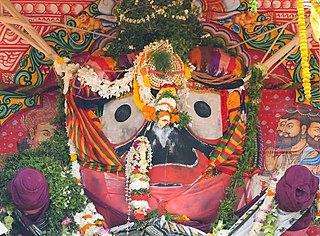
Jagannath is a deity worshipped in regional Hindu traditions in India and Bangladesh as part of a triad along with his brother Balabhadra, and sister, Subhadra. Jagannath, within Odia Hinduism, is the supreme god, Purushottama, and the Para Brahman. To most Vaishnava Hindus, particularly the Krishnaites, Jagannath is an abstract representation of Krishna, or Vishnu, sometimes as the avatar of Krishna or Vishnu. To some Shaiva and Shakta Hindus, he is a symmetry-filled tantric form of Bhairava, a fierce manifestation of Shiva associated with annihilation.
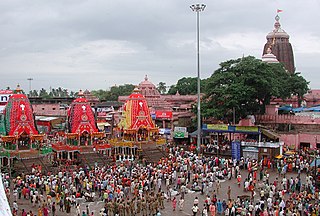
The Ratha Yatraof Puri, also rendered as the Ratha Jatra is a Hindu festival associated with the deity Jagannath held at Shri Kshetra Puri Dham in the state of Odisha, India. It is the oldest Ratha Yatra, whose descriptions can be found in Brahma Purana, Padma Purana, the Skanda Purana, and the Kapila Samhita. This Ratha Yatra is the celebration of the occasion of the deity Jagannath, a form of the Hindu deity Vishnu or Krishna, journeying towards his aunt's house. Adherents mark this occasion as Jagannath's annual visit to the Gundicha Temple via Mausi Maa Temple near Saradha Bali, Puri.

Puri is a coastal city and a municipality in the state of Odisha in eastern India. It is the district headquarters of Puri district and is situated on the Bay of Bengal, 60 kilometres (37 mi) south of the state capital of Bhubaneswar. It is also known as Sri Jagannatha Dhama after the 12th-century Jagannath Temple located in the city. It is one of the original Char Dham pilgrimage sites for Hindus.

Gajapati district is a district of Odisha State in India. It was created from Ganjam District on 2 October, 1992. Gajapati district was named after Krushna Chandra Gajapati Narayan Deb, the King of the Paralakhemundi estate and the first Prime Minister of Orissa, who is remembered for his contribution in the formation of a separate state, and inclusion of his estate in Odisha. The district headquarters at Paralakhemundi, formerly a Zamindari, has been clustered within a radius of approximately 5 kilometers around the geometric centre of Paralakhemundi. The District is a part of the Red Corridor. As of 2011 it is the third least populous district of Odisha, after Debagarh and Boudh.
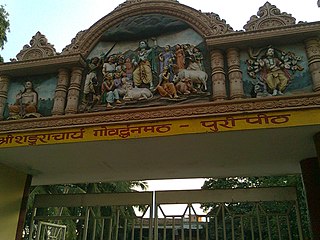
Purvamnaya Sri Govardhana Peetham or Govardhan Math is one amongst the four cardinal peethams established by the philosopher-saint Bhagwan Adi Shankaracharya to preserve and propagate Sanatana Dharma and Advaita Vedanta, the doctrine of non-dualism. Located in Puri in Odisha, India, it is the Eastern Āmnāya Pītham amongst the five Peethams, with the others being the Sringeri Śārada Pīṭhaṃ (Karnataka) in the South, Dvārakā Śāradā Pītham (Gujarat) in the West, Badari Jyotirmaṭha Pīṭhaṃ (Uttarakhand) in the North .It is associated with the Jagannath temple. Their Vedantic mantra or Mahavakya is Prajñānam brahma and as per the tradition initiated by Adi Shankara it holds authority over Rig Veda. The head of the matha is called Shankarayacharya, the title derives from Adi Shankara.
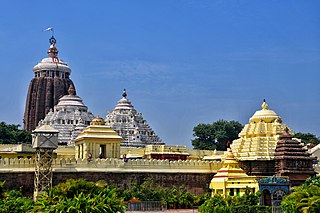
The Jagannath Temple is an important Hindu temple dedicated to Jagannath, a form of Vishnu – one of the trinity of supreme divinity in Hinduism. Puri is in the state of Odisha, on the eastern coast of India. The present temple was rebuilt from the tenth century onwards, on the site of pre-existing temples in the compound but not the main Jagannatha temple, and begun by Anantavarman Chodaganga, the first king of the Eastern Ganga dynasty.

Dhenkanal State was one of the princely states of India during the period of the British Raj. The state is now referred to as Dhenkanal district, Odisha, with Dhenkanal town as its district headquarters.
The Madala Panji is a chronicle of the Jagannath Temple, Puri, Odisha, India. It describes the historical events of Odisha related to Lord Jagannath and the Jagannath Temple. The Madala Panji dates from the 12th century.
Jayakrushna Rajaguru Mohapatra popularly known as Jayi Rajaguru was a prominent figure of the Indian independence movement in the state of Odisha. A princely-priest by profession at the court of the Khurda kingdom, Rajaguru revolted against the British East India Company in the province. Whilst collaborating with the Marathas to recapture the British-controlled province, a Maratha messenger was caught by the British and Rajaguru's secret strategies got exposed. Upon failure of his removal from the king's court, a British force attacked the fort of Khurda and captured Rajaguru. He was later sentenced to death and executed in Baghitota, Midnapore.
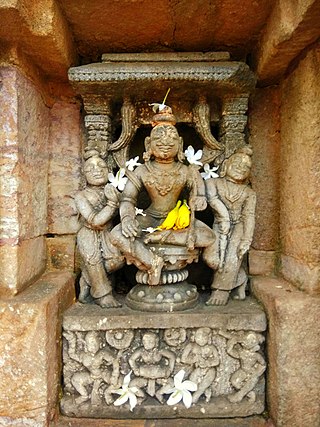
Kapilendra Deva was the founder of the Suryavamsa Gajapati Empire that ruled parts of eastern and southern India, including present-day Odisha as the center of the empire. He came to the throne after staging a military coup against the preceding and the last ruler from the Eastern Ganga dynasty, Bhanu Deva IV. His name is also written as Kapilendra Routray or Sri Sri Kapilendra Deva. Kapilendra claimed descent from the Surya Vamsha of the Mahābhārata and took the title of shri shri ...(108 times) Gajapati Gaudeshwara NabaKoti Karnata Kalabargeswara or the lord of Bengal (Gauda), of the Karnataka region or Vijayanagara, the lord of Gulbarga and of nine crore subjects.
Biranarasingh Pur is one of the oldest sasana village in Puri district in Odisha. The village is named after the great king of Odisha Gajapati Narasingh Dev. The then king of Odisha Gajapati Ramachandra Deva was a patron of Brahmins. He set up 16 Brahmin villages in different parts of the district Puri in order to arrange pujas and jagnyas in Jagannath Temple, Puri. The renowned Brahmins of different parts of country were brought by the king and then these 16 villages were established. These villages were known as sasanas. In those days villages were considered as the backbone of India. So these 16 sasanas had a great significance. Some of the elderly Brahmins of these villages were used to counsel the king for the welfare of state. Also only the Brahmins of some selected sasanas has the right to sit on the prestigious Mukti Mandap in Jagannath Temple, Puri. These sasana villages were characterized by a prefix Bira before the name of the village. For example- Biranarasingh Pur, Biraharekrushna Pur, Birabiswanath Pur etc. These villages are closely related to the Jagannath temple culture.

Shri Shri Hari Baladev Jew Bije is a famous Hindu temple located in Baripada, Mayurbhanj district, in the state of Odisha, India. The name Jagannath is a combination of the Sanskrit words Jagat (Universe) and Nath.
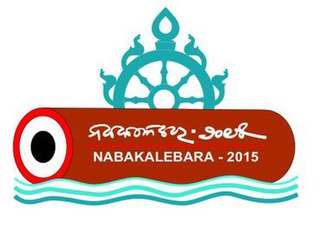
The Nabakalebara 2015 is a celebration of the ancient ritual of the Nabakalebara associated with most of the Jagannath Temples when the idols of Lord Jagannath, Balabhadra, Subhadra and Sudarshan are replaced by a new set of idols; the last such festival of events was held in 1996. The period of the festival is chosen according to the Hindu Calendar, conforming to the astrological planetary positions. The festival during 2015 involves several schedules, and it has started from 23 March with Banajaga Yatra and will conclude with Rathayatra followed Sunabesa on 27 July, with many other rituals being held in between on specific dates. More than 5 million devotees are expected to participate in these rituals held in and around the temple complex of the Jagannath Temple, Puri, Odisha.

Jagannath Temple, Rayagada, stands at the southern side of the town Rayagada. The temple was originally built more than 50 years back.

Vira Pratapa Purushottama Deva was the second Gajapati emperor of Odisha who ruled from 1467 to 1497 C.E. He was the second ruler from the Suryavamsa Gajapati Empire. His father Gajapati Kapilendra Deva Routaraya chose him as his heir to rule the Gajapati Empire at the banks of river Krishna where he breathed his last. This decision infuriated the elder brother Hamvira Deva who was a battle hardened and successful warrior fulfilling the task of conquering the southern territories and expeditions against the kingdom of Vijayanagara as wished by his father.

Dibyasingha Deba, known by the symbolic regnal title as Gajapati Maharaja Divyasingha Deva IV is the current titular Gajapati Maharaja and the King of Puri. He is the current head of the house of Bhoi dynasty, who were the hereditary rulers of the ancient realm of Trikalinga, medieval era Khurda Kingdom and the rulers of the Puri Estate, with their current capital located at Puri. The Gajapati Maharaja is the current Adhyasevaka of Lord Jagannatha and according to customs also considered to be the living reflection of the Lord. He is also the chairman of the Shri Jagannatha Temple Managing Committee of the Jagannath Temple at Puri.

The Bhoi dynasty or the Yaduvamsa dynasty were a medieval Hindu dynasty from the Indian subcontinent, which originated in the region of Odisha that reigned from 1541 to 1560 CE. Govinda Vidyadhara had usurped the throne from the later weaker Suryavamsa Gajapati Empire rulers as the kingdom started weakening but had a short-lived reign as ruling chiefs of Odisha as the ensuing internal rivalries and constant threats of invasions rendered them weak and were eventually overthrown by Mukunda Deva of Chalukya dynasty in 1560.
Gajapati Rāmachandra Deva I was the founder of the Bhoi dynasty of Khurda in Odisha, India. He became the ruler of Khurda kingdom after defeating Mukunda Deva in 1568. He claimed descent from the Yaduvanshi dynasty which features prominenetly in the Indian epic, Mahabharata. The Odia populace gave him the title of "Thakura Raja" as a mark of respect for renovating the damaged Hindu temples that were destroyed by the invasion of Kalapahad. He was titled as Vira Sri Gajapati Viradhi Viravara Pratapi Ramachandra Deva.
The Puri Estate was an estate ruled by the main branch of the Bhoi dynasty, who were reinstated in Puri in 1809 following the 1804 rebellion against the British and annexation of the Khurda Kingdom which were under their control. After the rebellion led by the Khurda king, Mukunda Deva II, the British decided to take control of the administration of the Khurda kingdom and Mukunda Deva II was exiled to Cuttack and Mindapore but was later reinstated and pensioned off to Puri to remain as a titular head of the dynasty while retaining control over the Jagannath Temple.
Gajapati is a regnal title from the region of modern Odisha in the Indian subcontinent. The word ‘Gajapati’ in Odia refers to "Gaja" meaning elephant and "Pati" meaning master or husband. Thus Gajapati etymologically means a king with an army of elephants. The institution of Gajapati kingship as a title was used by the Eastern Ganga dynasty and was used by succeeding dynasties, with the patronisation of Lord Jagannatha as the imperial deity of the Odia cultural realm.















